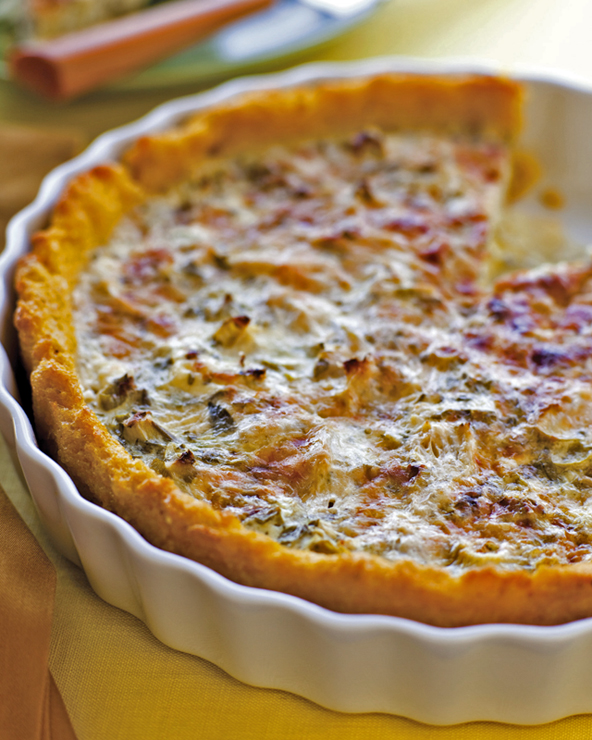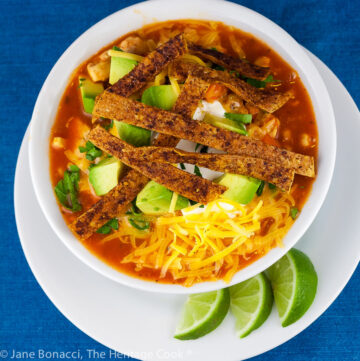There is an amazing cookbook that everyone who is interested in finding healthier, tastier options should have in their home library. It is Ancient Grains for Modern Meals written by Maria Speck. The focus of the book is to introduce us to grains that may not be at the top of our grocery lists.
Not surprisingly, there is an obvious bent toward Mediterranean recipes, but there is plenty for everyone … even Orange Scones, Dark Chocolate Cake, Pumpernickel Bread and Pizza! Maria covers everything imaginable including the variety of grains & flours, nuts & seeds, spices & herbs, helpful equipment to have, techniques, storage suggestions, how to work with whole grains, baking basics for whole grain flours, and her own musings on health, dieting, and good eating.
This book started ten years ago at the suggestion of one of Maria’s friends when she was savoring some of Maria’s homemade whole wheat brioches. Those must have been some pretty incredible brioches, LOL!

Artichoke-Rosemary Tart with Polenta Crust – Photo Credit: Sara Remington 2011
Maria’s love of food came from her Greek mother and grandmother and her German father and she grew up eating amazing homemade meals made with love and care. From the holiday meals prepared by her aunt and grandmother in Greece with their currant and pine nut-stuffed grape leaves to the contrasting cultures of her own home with her mother’s Mediterranean flavors blending with her father’s Germanic tastes. As Maria says, “My dad couldn’t imagine life without liverwurst; my mom suffered when she couldn’t find oranges or lemons.”
In this book you will discover amazing heritage grains like Farro, Kamut, Wheat Berries, Millet, Buckwheat, and Amaranth through the cuisines of Turkey, France, Italy, Israel, Spain, Tunisia, and Lebanon as well as Greece and Germany. Maria looks to her own favorites and shares them with abandon, hoping that we fall in love with them as she has.
This is not a preachy book, pressuring us to live a specific way or follow a prescribed diet. Rather, she wants us to try as many as we can and discover for ourselves how delightful ancient grains are. Maria believes that “eating is about pleasure first, and dieting last … food has to be mouthwatering and seductive to stay in our meal plan for good.” She uses rich natural ingredients like butter, cream and bacon, but always in moderation. She has given up on dieting and focuses instead on eating healthy whole grains, which give her energy, are filling and satisfying without being high in calories.

Fresh Artichokes
If you would like to “meet” Maria and hear her lovely soft accent, check out her video on her blog: http://mariaspeck.com/blog/. For those who are active on social media, you can keep up with her on her Facebook Fan Page and follow her on Twitter (@MariaSpeck).
As those of you who have been reading my blog for awhile know, I fell head over heels in love with Farro a couple of years ago, so I can completely understand Maria’s fascination and infatuation with whole grains. Their nutty chewiness and natural micronutrients make them some of nature’s perfect foods. The fact that you can use them in their natural form in both sweet and savory dishes as well as grind them and use the flour in place of our normal all-purpose flour makes it relatively simple to incorporate them into our lives nearly seamlessly.
Like many people today, I am always looking for ways to improve my diet without sacrificing flavor. It drives me crazy to see all the diet pills on the market and how many books there are prescribing this diet or that one, as if they are some kind of miracle for weight loss and health. The real secret is that whole grains contain iron, magnesium, B vitamins, antioxidants, vitamin E and fiber. Science has proven the following:
– Repeated studies have shown that a diet rich in whole grains significantly reduces the risk of major chronic diseases, such as heart disease, type-2 diabetes, and stroke.
– Eating three servings of whole grains per day can reduce the risk of certain cancers.
– People who eat whole grains regularly have a lower risk of obesity. They also have lower cholesterol levels.

Wheat Berry Fools – Photo Credit: Sara Remington 2011
In Ancient Grains for Modern Meals, Maria covers all the conceivable ways to utilize whole grains. From breakfast, brunch and breads to salads, sides, soups and stews. She covers burgers, savory cakes, pasta, and modern main dishes. And of course she wouldn’t miss including sweet desserts.
And just in case all this wasn’t enough to whet your appetite and make you want to run out and buy the cookbook, here is a list of some of the other recipes in the book that I can’t wait to try for myself:
- Leek Salad with Grilled Haloumi Cheese & Rye Berries
- Acorn Squash Soup with Spicy Yogurt Topping
- Barley Salad with Figs, Apples, and Tarragon-Lemon Dressing
- Lemon Quinoa with Currants, Dill, and Zucchini
- Spring Pilaf with Artichoke and Green Peas
- Tomato-Infused Bulgur Pilaf with Fresh Basil
- Roasted Prosciutto Rolls with Figs and Rosemary
- Creamy Rotelle with Basil Yogurt and Mozzarella
- Lamb Stew with Wheat Berries in Red Wine Sauce
- Italian Chocolate-Almond Cookies
- Almond-Peach Clafouti
The next time you are wandering through a bookstore, I hope you head to the cookbook section and look through Maria’s wonderful book. It is full of recipes that will instantly make you hungry and the photography of Sara Remington will have your mouth watering in anticipation.
And now, without further ado, here are today’s recipes!

Wheat Berries


- Polenta Crust
- 1-1/2 cups low-sodium vegetable broth
- 1-1/4 cups water
- 1/2 tsp fine sea salt
- 1-1/4 cups polenta or corn grits
- 1/2 cup shredded Parmesan cheese (about 2-1/2 ounces; use the large holes of a box grater)
- 1 large egg, at room temperature
- 1/4 tsp freshly ground black pepper
- Artichoke Cheese Filling
- 1 cup plain whole-milk Greek yogurt
- 2 large eggs
- 1/2 cup finely chopped green onions (about 3)
- 2 tbsp chopped fresh flat-leaf parsley
- 1 tbsp minced fresh rosemary
- 1/4 tsp fine sea salt
- 1/4 tsp freshly ground black pepper
- 1 (12 oz) package frozen quartered artichoke hearts, thawed and drained
- 2 oz crumbled goat cheese (about 1/2 cup)
- 1/2 cup shredded Parmesan cheese
- To make the polenta crust, bring the broth and the water to a boil in a large heavy-bottomed saucepan over medium-high heat. Add the salt. Using a large whisk, slowly add the polenta in a thin stream, and continue whisking for 30 more seconds. Decrease the heat to low and cover. Cook for 10 minutes, stirring vigorously with a wooden spoon about every 2 minutes to keep the polenta from sticking to the bottom. Remove the saucepan from the heat and let sit, covered, for 10 minutes, stirring a few times. The polenta will be fairly stiff. Stir in the cheese, egg, and pepper.
- Grease a 10-inch ceramic tart pan with olive oil or coat with cooking spray, and place on a wire rack. Have ready a tall glass of cold water. Dip a wooden spoon into the water as needed as you spread the polenta mixture across the center of the pan, pushing it up the sides. Set aside to firm up at room temperature, about 15 minutes, and then form an even rim about 3/4 inch thick with your slightly moist fingers, pressing firmly. No need to fret over this—it’s easy.
- Meanwhile, position a rack in the center of the oven and preheat to 375°F.
- Prepare the artichoke cheese filling. Place the yogurt, eggs, green onions, parsley, rosemary, salt, and pepper in a 2-cup liquid measure or a medium bowl and combine well with a fork. Distribute the artichoke quarters over the crust, cut sides up, forming a circle along the rim and filling the center (you might not need all the hearts). Sprinkle the goat cheese on top and gently pour the filling over the artichokes. Sprinkle with the Parmesan cheese.
- Bake the tart until the top turns golden brown and the filling is set, about 45 minutes. Transfer the pan to a wire rack and set aside at room temperature to firm up for at least 20 minutes, 40 if you can wait. Using a sharp serrated knife, cut into slices. Serve with more freshly ground pepper on top if you like.
- To get a head start: The polenta crust, as in steps 1 and 2, can be prepared 1 day ahead, as can the entire tart. Cool to room temperature, chill for a couple of hours, and then cover with plastic wrap. Allow the tart to come to room temperature before serving, or gently reheat to warm (not hot) in a 325ºF oven for about 20 minutes.
- Serves 4 as a main course, or 8 as a starter
- To lighten it up: Use 1 cup non or low-fat Greek yogurt in the filling instead of whole-milk yogurt.


- 3/4 cup finely chopped dried figs, preferably Turkish or Greek
- 3 tbsp Grand Marnier or other good-quality orange-flavored liqueur
- 1 cup plain whole-milk Greek yogurt
- 4 tbsp honey
- 1 tbsp plus 1 tsp freshly grated orange zest (about 2 oranges)
- 1/4 tsp ground cinnamon
- 1 cup cooked soft whole wheat berries
- 1 cup heavy whipping cream, chilled
- Combine the figs and the liqueur in a small bowl and set aside to plump for 15 minutes, stirring once or twice, while you prep the ingredients.
- Meanwhile, beat the yogurt with 2 tbsp of the honey, 1 tbsp of the orange zest, and the cinnamon in a large bowl until smooth. Stir in the wheat berries. Using a hand mixer at medium speed, whip the cream in a medium bowl until foamy. Add the remaining 2 tbsp honey and continue whipping until soft peaks form.
- Drain the figs, reserving their juices. Combine 2 tbsp of the figs with the remaining 1 tsp zest in a small bowl and set aside for garnish. Stir the remaining figs into the bowl with the yogurt mixture. Scrape one-third of the whipped cream on top and fold in using a spatula. Fold in the remaining whipped cream in 2 additions until just incorporated.
- Divide among serving bowls, cover with plastic wrap, and chill for 2 hours. To serve, top each bowl with a bit of the reserved figs and their juices.
- Serves 6 to 8.
- To get a head start: The dessert can be prepared up to 4 hours ahead. Add a dash more liqueur to the figs reserved for the garnish, if necessary.
- To lighten it up: You can use low-fat plain Greek yogurt, if you like.
Thank You!







Rhonda
Jane, that looks amazing. I’ve been eyeballing that cookbook for awhile, sounds like it’s a real winner.
Jane Bonacci, The Heritage Cook
It is a wonderful book Rhonda – you should check it out when you have a chance!
Jane Bonacci, The Heritage Cook
Yea Greg! Ohio just isn’t going to be the same after we arrive, LOL!!
sippitysup
Love the polenta crust, and looking forward to meeting you at dinner on Thursday. GREG